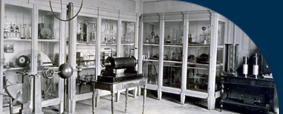 |
Franklin's boiler |
 |
Bollitore di Franklin |
| Subjects: heat/ether evaporation by hand heat |
Settore: calore/ebollizione dell'etere con il calore di una mano |
| Inventory Number: 253 |
Numero di inventario: 253 |
| Gaetano Pizzali, Perugia [document] |
Gaetano Pizzali, Perugia [documento] |
| 1868 [document] |
Periodo di costruzione: 1868 [documento] |
| Glass, ether |
Materiale utilizzato: Vetro, etere |
| 190 X 35 X 50 [mm] |
Dimensioni: 190 x 35 x 50 [mm] |
| |
|
This simple device shows the influence of pressure on the boiling point temperature of a liquid. The heat of a hand alone is sufficient to produce the clear and lively boiling of ether: the principle of its functioning derives from the first Galilean experiments with heat: they were related to the building of thermoscopes that used the dilatation of air to register little temperature differences in sealed bulbs filled with water.
|
Questo semplice apparato visualizza l'influenza della pressione sulla temperatura di ebollizione di un liquido. Il solo calore di una mano è infatti sufficiente a produrre con evidenza la vivace ebollizione dell'etere. Il suo principio di funzionamento trae origine dalle prime esperienze galileiane sul calore, legate alla costruzione di termoscopi che sfruttavano la dilatazione dell'aria per registrare piccole variazioni di temperatura in bulbi (chiusi) pieni d'acqua. |
| |
|
Description: The glass instrument consists of a pair of spheres linked to one another through a handle-bar shaped tube having a small diameter. In the centre of the tube there is a small spout sealed by a flame. Before sealing it, coloured ether (pale yellow in this case) was introduced into the ampoules and brought to a boil to displace the air within the device thus creating a vacuum. Ether, in this particular condition, bears only its own vapour pressure, which at room temperature is generally low (~ 459 mm Hg at T = 25° C). |
Descrizione: l'apparato in vetro si compone di una coppia di sfere cave collegate tra loro tramite un cannello a manubrio, di piccolo diametro. Questo presenta centralmente una punta tirata a beccuccio, saldata tramite fiamma. Prima di chiuderla, si introduceva dell'etere colorato (giallo paglierino, nel nostro caso) nelle ampolle e lo si faceva bollire per far evacuare, tramite lo svolgimento dei suoi vapori, tutta l'aria contenuta nell'apparato. L'etere così preparato sopporta unicamente la propria tensione di vapore che, a temperatura ambiente, è generalmente piccola ( ~ 459 mm Hg a T = 25º C). |
| |
|
Function: By holding one of the two spheres in your hand and by keeping the instrument horizontal, the heat of your hand alone produces the sudden boiling of the liquid in the other sphere due to the pressure exerted by vapour. |
Funzionamento: abbracciando una delle due sfere e tenendo orizzontale lo strumento, il solo calore della mano produce la spinta del liquido nell'altra sfera e la sua repentina ebollizione per effetto della pressione sottostante esercitata dal vapore. |
| |
|
Bibliography: Ganot [1855], pp. 268-269; Salleron [1864], troisième et quatrième parties, p. 225. |
Bibliografia: Ganot [1855], pp. 268-269; Salleron [1864], troisième et quatrième parties, p. 225. |

